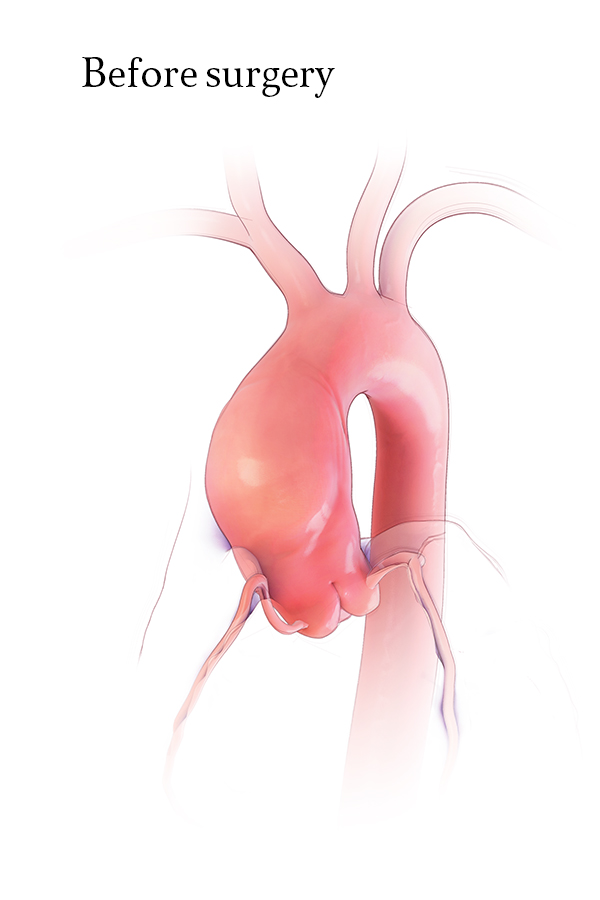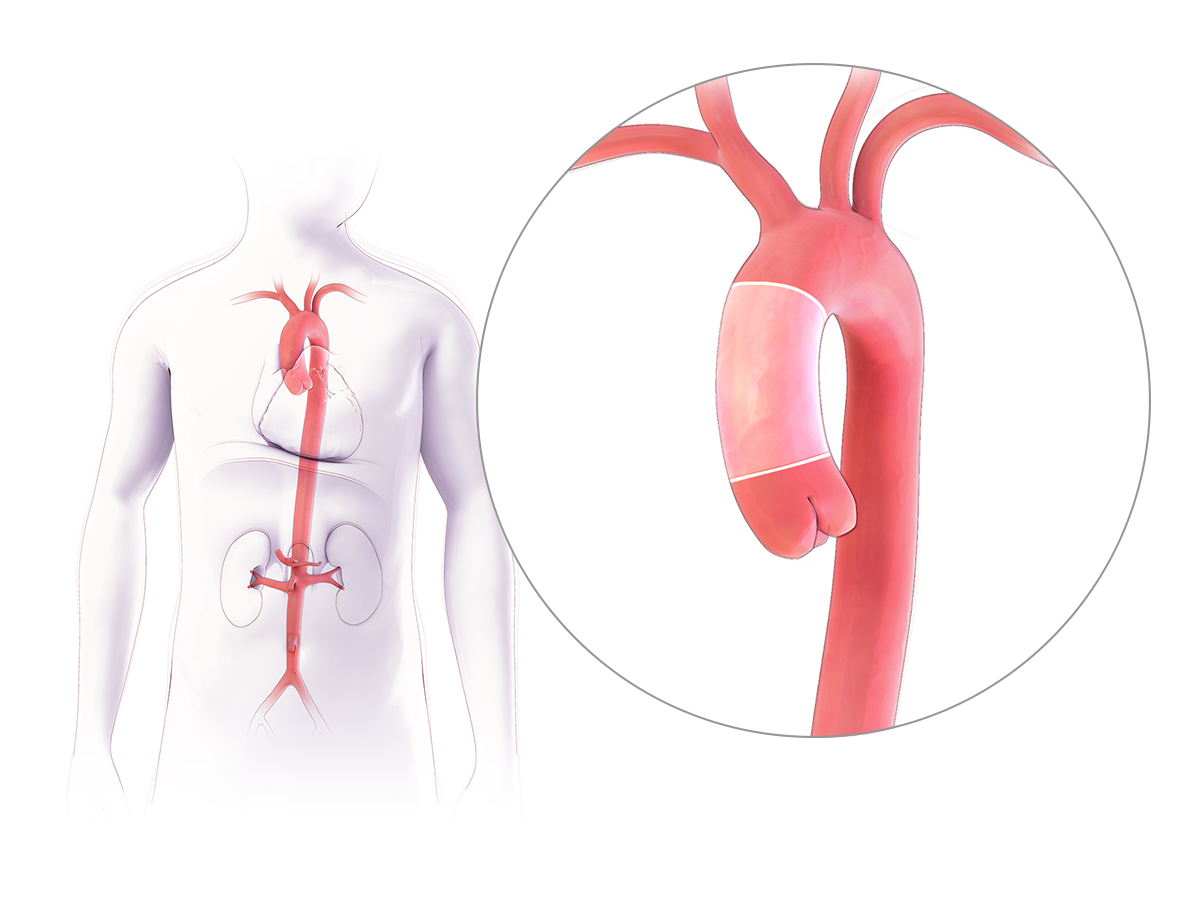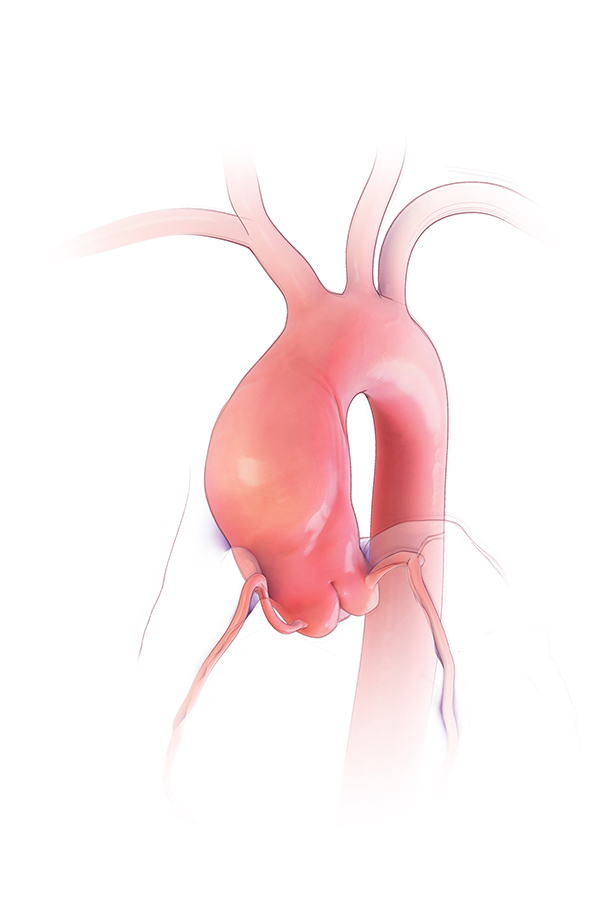Your Ascending Aorta and Aortic Arch
The ascending aorta begins above the aortic root and extends towards the neck until it begins to turn and give rise to the aortic arch. The ascending aorta is more frequently affected by aneurysms and dissections and requires open heart surgery to be repaired.
Aortic Valve and Ascending Aorta Replacement with Hemiarch Replacement
This procedure is indicated for patients who are diagnosed with aneurysm or dissection of the ascending aorta and have an abnormally functioning aortic valve. The procedure involves aortic valve replacement combined with replacement of the ascending aorta and the underside of the aortic arch with a Dacron graft.


Interactive 1. Aortic Valve and Ascending Aorta Replacement with Hemiarch Replacement
Drag the circle side-to-side
Aortic Valve Resuspension and Ascending Aorta Replacement with Hemiarch Replacement
This procedure is indicated for patients who are diagnosed with aneurysm or dissection of the ascending aorta and have a normal appearing aortic valve. The procedure involves preservation of the patient’s native aortic valve combined with replacement of the ascending aorta and the underside of the aortic arch with a Dacron graft.


Interactive 1. Aortic Valve Resuspension and Ascending Aorta Replacement with Hemiarch Replacement
Drag the circle side-to-side
Mechanical Composite Root with Hemiarch Replacement
This procedure is indicated for patients who are diagnosed with aneurysmal disease involving the aortic root and ascending aorta with abnormal aortic valve leaflets. The procedure involves excision of all diseased aortic root tissue and the aortic valve leaflets, followed by replacement of the aortic root complex with a mechanical valve that is sewn inside a Dacron graft. The left and right main coronary arteries are subsequently reimplanted into the graft with fine permanent suture. The ascending aorta and underside of the aortic arch are replaced with a separate Dacron graft, and the two grafts are connected together to complete the proximal aortic reconstruction.


Interactive 1. Mechanical Composite Graft Repair with Hemiarch Replacement
Drag the circle side-to-side
Bioprosthetic Valved Conduit Root with Hemiarch Replacement
This procedure is indicated for patients who are diagnosed with aneurysmal disease involving the aortic root and ascending aorta with abnormal aortic valve leaflets. The procedure involves excision of all diseased aortic root tissue and the aortic valve leaflets, followed by replacement of the aortic root complex with a bioprosthetic (porcine or bovine) valve that is sewn inside a Dacron graft. The left and right main coronary arteries are subsequently reimplanted into the graft with fine permanent suture. The ascending aorta and underside of the aortic arch are replaced with a separate Dacron graft, and the two grafts are connected together to complete the proximal aortic reconstruction.


Interactive 1. Bioprosthetic Valved Conduit Repair with Hemiarch Replacement
Drag the circle side-to-side
Porcine BioRoot with Hemiarch Replacement
This procedure is indicated for patients who are diagnosed with aneurysmal disease involving the aortic root and ascending aorta with abnormal aortic valve leaflets. The procedure involves excision of all diseased aortic root tissue and the aortic valve leaflets, followed by replacement of the aortic root complex with with a full porcine aortic root which includes a porcine valve. The left and right main coronary arteries are subsequently reimplanted into the graft with fine permanent suture. The ascending aorta and underside of the aortic arch are replaced with a separate Dacron graft. The porcine root and neo-ascending aortic graft are connected together to complete the proximal aortic reconstruction.


Interactive 1. Porcine BioRoot Repair with Hemiarch Replacement
Drag the circle side-to-side
Type A Aortic Dissection with Aortic Valve Resuspension, Hemiarch Replacement and Descending Stent Graft (Type A Hybrid)
This procedure is indicated for patients who are diagnosed with an aortic dissection involving the ascending aorta. The procedure involves excision of the ascending aorta and underside of the aortic arch, and placement of a thoracic aortic stent graft into the descending aorta at the time of arch repair. The native aortic valve and root are repaired, and the ascending aorta and proximal arch are replaced with a Dacron graft.


Interactive 1. Bioprosthetic Valved Conduit Repair with Hemiarch Replacement
Drag the circle side-to-side
Total Arch Replacement with Reimplantation of Great Vessels
This procedure is indicated for patients who have aneurysmal disease that involves the entire aortic arch. The procedure involves excision of the ascending aorta and aortic arch. The great vessels (innominate, left carotid and left subclavian arteries), which supply the brain and upper extremities, are separated from the arch. The ascending aorta and arch are replaced with a customized, Dacron, multi-branched arch graft, and the great vessels are individually re-attached to the branches of the arch graft.






